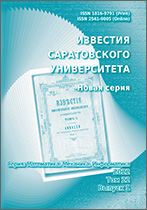|
Scientific Part
Mechanics
Cylindrical shell with a circular hole under various loads: Comparison of analytical and numerical solutions
S. V. Kashtanovaa, A. V. Rzhonsnitskiyb
a Institute for Problems in Mechanical Engineering of the Russian Academy of Sciences, 61 Bolshoi prospect V.O., St. Petersburg 199178, Russia
b Saint-Petersburg State Institute of Technology, 26 Moskovski Ave., St. Petersburg 190013, Russia
Abstract:
In this paper, the authors present the results of calculations of the stress field of a cylindrical shell weakened by a circular hole and under the influence of various loads: uniaxial tension, internal pressure and torsion. Six simplified equations of the theory of cylindrical shells with a high variability index (coinciding with the equations of the theory of shallow shells) are reduced to an equation of mathematical physics with respect to the stress potential, which is solved by the Fourier method. The main obstacle to obtaining an answer is the need to search for coefficients in the decomposition of the solution into the sum of the basis functions for which this solution satisfies the boundary conditions. Also, this equation depends on the parameter $\beta$, which is responsible for the relationship between the geometric characteristics of the shell and the hole. From a mechanical point of view, for small and medium holes, this parameter has limitations of $\beta\leq 4$, because for large values, the hole is considered large, and the general equations of the theory of cylindrical shells are used to describe the stress-strain state. At the same time, a detailed study of classical works has led to the understanding that none of the previously proposed methods for finding coefficients can be considered definitively successful, and the results obtained by these methods vary. Among the variety of works by Soviet and Western scientists of the 1960-70s years of the twentieth century, the numerical results of engineer Van Dyke, which he obtained by collocation, stand out. Unlike his contemporaries, who lay out the solution in a row for a small parameter $\beta$ and therefore get results only close to the flat case, Van Dyke first published results for the entire working range of the parameter $\beta$ in the framework of considering small and medium holes. The authors proposed a new approach based on the decomposition of basic functions into a Fourier series. For the first time, it was possible to compose an infinite system of linearly independent equations for finding unknown coefficients. It is essential that the proposed method, unlike the well-known small parameter method, has no mathematical limitations and can be used not only for the values of the parameter $\beta$ close to zero, but for any values. Restrictions up to $\beta=4$ are imposed by the mechanical model. In this paper, systems for finding unknown coefficients for basic functions for three types of loads are compiled, and the results obtained by the authors are compared with the results obtained by the numerical method. At the same time, if in most sources only the results of calculating the circumferential stresses at the boundary of the hole are given, in the proposed work the stress field for the entire cylindrical shell is found, arising due to the presence of the hole, depending on the polar coordinates $(r,\theta)$.
Key words:
cylindrical shells, shell with cutouts, axial tension, inner pressure, torsion, stress field, analytical approach.
Received: 21.03.2022
Accepted: 01.11.2022
Citation:
S. V. Kashtanova, A. V. Rzhonsnitskiy, “Cylindrical shell with a circular hole under various loads: Comparison of analytical and numerical solutions”, Izv. Saratov Univ. Math. Mech. Inform., 23:2 (2023), 195–206
Linking options:
https://www.mathnet.ru/eng/isu978 https://www.mathnet.ru/eng/isu/v23/i2/p195
|

|




 Contact us:
Contact us: Terms of Use
Terms of Use
 Registration to the website
Registration to the website Logotypes
Logotypes








 Citation in format
Citation in format 